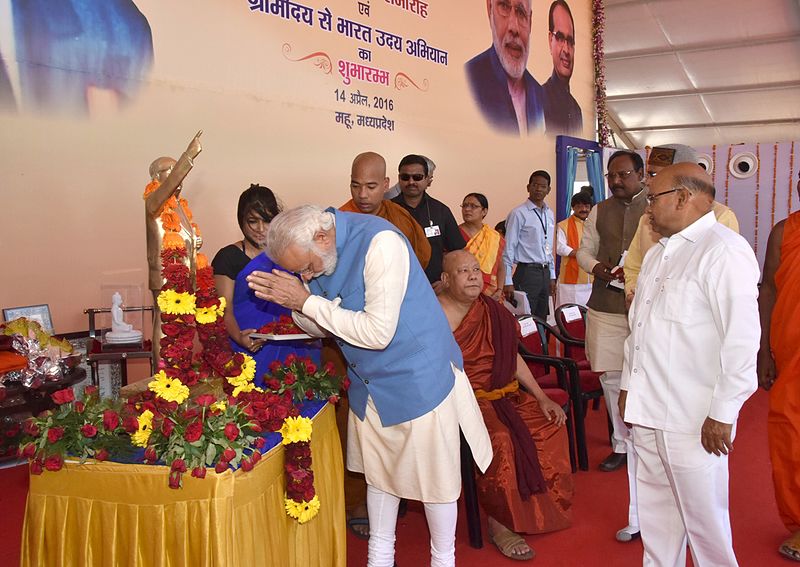
When the Indian Constitution was adopted in January 1950, B.R. Ambedkar stated that India was entering a life of contradictions for he believed that political equality alone is not a sufficient condition for social and economic democracy.
This proclamation of Babasaheb could not be more relevant today, when massive socio-economic inequalities and callous atrocities against minorities demand a politics of inclusivity. However, to speak of Hindu Nationalism and Ambedkarism in the same breath is an appropriation of Ambedkar’s legacy by the very ideological and religious structures he fought against.
The latter is in fact a revolutionary force directed to emancipate the oppressed from the oppressive structures of the former. In recent times, the need to appropriate Ambedkar as an icon of ‘social justice’ and ‘inclusive growth’ stems from a political desperation of the ruling regime. Not only do we see an attempt to saffronise Ambedkar, but BJP sympathizers use political generosity as a tactic when the state complicity in dealing with socio-economic oppression is apparent. The current government and the right wing intellectuals like Sanjay Paswan consciously gloss over the historical contestation between Ambedkarism and Hindu Nationalism. This article is written in response to Sanjay Paswan’s piece ‘You can be a Hindu Nationalist and an Ambedkarite both’ dated 14th April 2019.
In the article, Mr. Paswan argues that since Ambedkar recognized religion as an essential component of society, one could possibly be “a Hindu, a nationalist and an Ambedkarite – without there being any contradiction.” However, Paswan fails to capture Ambedkar’s favorable view on the need for religion in its entirety. While acknowledging its necessity, Ambedkar categorically asserts that he prefers ‘a religion of principles’ over ‘a religion of rules’.
Thus he unequivocally rejected Hinduism for its scriptural and social rigidity premised on the tenets of Manusmriti. Therefore, for Ambedkar, conversion to Buddhism was a radical dissent against the social order of caste in Hinduism. Religious conversion like constitutionalism provided ‘a possibility of a new principle’ founded on equality and equal opportunities in the social and economic realms respectively. In this light, it is a gross mistake or subversion to assume Buddhism as a mere “offshoot of Hinduism” when it was instead a deliberate rejection of the casteist social order under Hinduism. Buddhism was also a consciousness raising exercise for Ambedkar.
On one hand, Mr. Paswan acknowledges Ambedkar’s call for Dalits to convert from Hinduism to Buddhism but on the other he also argues that Hindu nationalism complied with Ambedkar’s beliefs. Based on this contention, we feel that Mr. Paswan’s attempt to integrate Hindu nationalism within Ambedkarism is a mere appropriation as Ambedkar found no possibility for reform within Hinduism and therefore looked outside it for solution. For him, the religion of Buddha, unlike other religions, had the capacity to change according to times because of its emphasis on reason and not on rules and its premise of equality not hierarchy. Moreover, when it comes to the temple entry movement, Ambedkar used it as a means to energize the Dalits to make them aware of their social position. It was in no way an attempt to make Dalits an integral part of the Hindu society, which in his opinion needed a total overhaul. Paswan’s claim that “Dalits are devout Hindus” blatantly erases the historicity of Dalit assertion against Hindu antagonism. He seems to worry more about Hindu religion instead of the people who suffer the burden of discrimination in its name.

Not only Hinduism but also its offshoot- caste, has a great appropriating capacity. Owing to rapid modernization and a subsequent movement towards universalist values over time, these ideas have started losing ground in our society. Hence, the survival of these irrational and degenerating systems depends on their coalescing with the ruling sentiments of our times i.e.- nationalism and neoliberalism. The anachronistic structure of caste recaptures even the new possibilities of social life (love, entrepreneurship, new religion, social reform etc) within its ambit to reproduce and reify power. This parent-child duo of Hinduism and caste then seeks to embezzle Ambedkar and subvert his thoughts and ideas to gain legitimacy in the society.
Coming to the core of Mr. Paswan’s argument that one can be both a Hindu Nationalist and an Ambedarkite, it is worthwhile to note what Nationalism meant to Ambedkar.
Ambedkar unequivocally argues that, “Indian Nationalism has developed a new doctrine which may be called the divine right of the majority to rule the minorities according to the wishes of the majority. Any claim for the sharing of power by the minority is called communalism while the monopolizing of the whole power by the majority is called Nationalism”.
His scathing analysis articulates how Hindu majoritarianism in India charted a vision for nationalism which is premised on the communalism of the majority; a biting truth that Mr. Paswan conveniently chooses to discount in his argument. Hindu nationalism is an actively pursued Right Wing political project of animating and marshalling Hindu sentiments; forging them in the mold of nationalism. A glaring testimony to the electoral desperation of the BJP is how the trope of nationalism is used to appropriate the Dalits within its ambit as long as they demonstrate their ‘Hindu’ credentials. Ambedkar would have found this despicable for he described analogically that any attempt to contain Dalits within Hinduism is like trying to make nectar out of poison.
For Ambedkar, Hinduism is ‘a collection of castes’ with Brahmanism establishing its central tenets. He claimed that these castes unite only when a common enemy is evoked in the form of an ‘outsider-other’, which often times is the Muslim and sporadically also comprises the Christians too. This made him believe firmly that Hindus cannot be imagined as a nation because there is no ‘Hindu consciousness of kind’ but only a consciousness of caste. The Bharatiya model of Nation State (Hindu Rashtra) that the right wing forces advance is based on an imagined Hindu unity that creates an external enemy out of non-Hindus and treats the Dalits as second class citizens. The constitutional foundation of our nation premised on liberty, equality and fraternity is thus antithetical to the undemocratic character of Hindu society. For Ambedkar, Hinduism is founded on the principles of separation (into a hierarchy of castes) and hence cannot be compatible with a formation of a social union.
As stated above, the Dalit politics of BJP is a double faced maneuver– the politically generous and the socially oppressive. While Mr. Paswan is quick to enlist facts on the representation of Dalits in the parliament under the ruling government, he fails to address the targeted attacks on Dalits by communal Hindu elements, such as the institutionalized murder of Dalit students and cow vigilante assaults and the consistent state endorsement of these crimes. In the political sphere, paying a lip service over ‘inclusiveness’ and a fervent display of love for Ambedkar by constructing memorials in his name, is used to conceal the state sanctioned anti-Dalit sentiments and brutal attacks against them in the social sphere.
Moreover, this dichotomous tactic is utilized to mitigate the effect of any Dalit assertion which ideologically differs from the BJP and RSS. The apathy towards sewerage deaths happening in the country is a testimony to how much the current dispensation worries about Safai Karamcharis in the country. Hence, we believe that Hindu Nationalism is merely a majoritarian ploy for consolidation of votes where Dalits are reduced merely into a vote bank.
In his article, Mr. Paswan asserts that “Ambedkar was no Karl Marx” and portrays them as opposing ideological figures. However, contrary to what Mr. Paswan wants us to believe, Ambedkar actively engaged with Marx but also recognized the distinctive characteristics of Indian society. According to him, the Indian society is organized around the division of laborers based on caste instead of a division of labour as conceptualized by Marx. Ambedkar took into cognizance the freedom of selling one’s labor for an equal pay as a means to uplift the outcasts, enabling them to assert themselves as dignified beings of equivalent worth. While caste and labor are historically produced, the former is locally situated and perpetrated whereas the latter is a universal principle for social existence. Ambedkar wanted to turn the unpaid labor of the exploited castes into socially acknowledged labor value that is universally in place. This, as one could understand, gives the oppressed castes the right to earn wage and dignity of work. It provides a means for their service to become a commodity and their labor power to have an exchange value.
Without discounting the exploitative nature of capitalism, Ambedkar did not shy away from recognizing the liberating potential of labor for individual agency and upward mobility. In other words, he fought the particularistic-historicity that is casteism with the universalist historicity that is labor which not only rescues them from oppression but also enables them to organize under a political project. This provides an opportunity for critical consciousness essential for the oppressed to rise against the slavery imposed upon them through casteist religious structures. In this light, we believe that Ambedkar’s ideals find some resonance with the revolutionary possibilities envisioned by the Left. However, the communists who actively engage with Ambedkar now did not see him as their comrade then. It is only in recent times, the Left is realizing the fact that the class relations alone cannot explain the social reality in India because caste as an ascriptive social hierarchy significantly governs the social order.
Ambedkar is a fierce social thinker whose work can reach youngsters without any external validation, from either the leftists or the so-called Hindu nationalists. He ought to be understood in his own might. But what we need to understand is why the proponents of Hindu nationalism are antagonistic to the communists. The answer lies in the fact that communism is in principle against private capital and religious dogmas. Such an ideological edifice vis-a-vis others is difficult to appropriate since it is diametrically opposite to the hybrid mix of neo-liberalism and Hindu nationalism. And hence, there exists hostility.
To conclude, BJP and their sympathizers would benefit more if they face the internal contradictions and dilemmas within their ideology rather than bashing the Left and the Liberals for their survival. Instead, the Hindu nationalist are busy dividing the country into category A, B, C and D according to the loyalty of the voter base. Ambedkar asserted that a country that undertook secularism and democracy as its guiding political spirit cannot trust such divisive forces. The pressing need is to create a just and equal environment for the structurally underprivileged Scheduled Castes, Tribes and the Minorities instead of providing a cosmetic political tokenism. It would indeed be a disservice to the legacy of BR Ambedkar if the present government is allowed to appropriate him.
Aishani and Saravanan are M. phil Research Scholars at the Centre for the Study of Social Systems at Jawaharlal Nehru University, Delhi.












